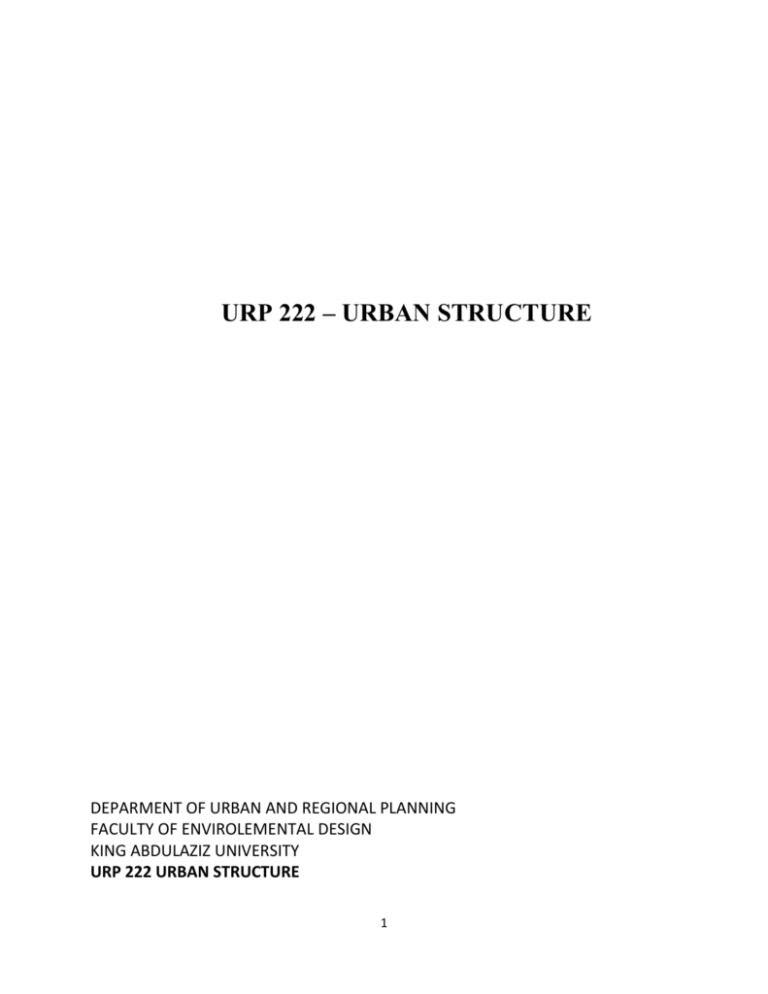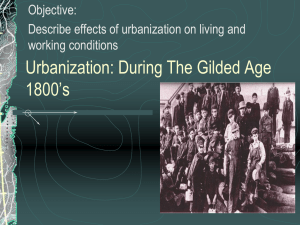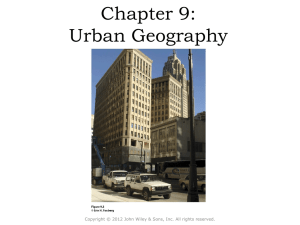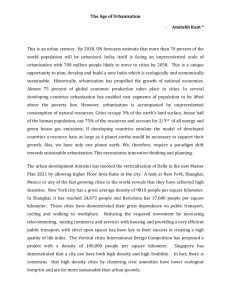URP 222 * URBAN STRUCTURE
advertisement

URP 222 – URBAN STRUCTURE DEPARMENT OF URBAN AND REGIONAL PLANNING FACULTY OF ENVIROLEMENTAL DESIGN KING ABDULAZIZ UNIVERSITY URP 222 URBAN STRUCTURE 1 Course Number and Name URP 222 – Urban Structure Course Logistics Lecture Time and Room: Section 1: Sunday 10:00 – 1:00, Bulding40, Room 208. Course Instructor Name: Dr. Samer Baessa Office: FED Building, 3rd floor Contact: Phone 0555534527 Fax: URP department 00966 2 6952756 E-mail: sbaessa@yahoo.com Course Abstract The new five-year curriculum of the faculty of environmental design gives the Following course abstract: “The course deals with the spatial organization in urban areas. It includes land use patterns and uses densities and their influence, patterns and networks, services hierarchies, catchments areas, retails patterns, market areas, regional analysis, models of urban land use dynamics, and urban development controls” Course Description The course is a second level theory/seminar course, three credit hours, and two lectures per week. The course has no prerequisite. The course is an introductory course that focuses on descriptive aspects of urban areas and the forces that shape the urban area. The course tries to answer the question how does cities look like and how does they work and what forces shape them. In a more details description these forces are social, economic and environmental. The course therefore looks into the process of urbanization and the nature of the various land uses, viz., retail, offices, housing, recreation and industry and other services. The course includes a study of the descriptive and explanatory models if cities, viz.., theories and model of spatial patterns 2 of cities and rent theories, services ranges and catchments area etc. The physical from of cities is also introduced including densities, visual qualities and planning. The course also deals with issues of environmental psychology and perception, urban social structure, employment patterns, urban poverty and the creation of slums and squatters, pollution and development controls. Course Objectives Based on the previous description specific course objectives are: 1. To introduce the students to the range of physical, social ad economic issues and paradigms behind the shaping of the urban areas that are based in the discipline of urban and regional planning. 2. To introduce some salient urban phenomena in the shaping of the urban areas descriptively and analytically, with an assessment of these phenomena and particular emphasis on the spatial patterns and arrangements, the dynamics of urban growth and the process of land use change. 3. To examine the various components of urban built form and urban planning and to analysis the impact of these components. Course Outline by Sessions The Course of the Following Five Parts: 1. Urbanization Definition of urbanization, types of urbanisms, migration, settlement patterns; hierarchy, location and distribution, patterns of urbanization in developed and developing countries, world population situation, the growth of cities international development issues, the basic urbanization issues involved in international policy frames and the basic development indices, employment patterns, employment sectors and poverty, and the differences between the developed and developing countries. This part also includes urbanization in the Saudi Arabia, and the discussion settlement patterns and the growth of cities. 2. Urban Land Uses. This part introduce the descriptive and explanatory models from, viz…central place theory, urban spatial model, location theory, rent theories the structures of urban land prices, services range and catchments, the basic components and zones of urban land uses, and nature of the different land used and their location aspect, viz., retails, offices, leisure and recreation, 3 industry, housing transportation and community facilities. This part also introduces some applied techniques that use by the planners in the assessment of demand and supply aspect of different uses. 3. Physical Aspects of Urban Areas. Densities, definition of densities, methods of measurement of densities, issues related with densities such as health, safety, crowding, the concept of the compact city, the influence on infrastructure planning, urban sprawl, urban vacant lands, urban growth boundaries, zoning regulations and development controls, and housing poverty and the measurements of poverty, creation of slums and squatters and their general physical characteristics. This part also deals with descriptive aspects of randomly developed areas and the planned areas and the land subdivision process. This part also introduces the neighborhood concept, clustering, and the silent road system viz., grid patterns, super block, cull-de-sac, loop systems, linier and radical patterns. 4. Planning and the Environment This part discusses some salient concepts in the planning of urban areas such as pollution control in planning, population mobility and the creation of social areas and the concept of social planning, environment and behavior, and environmental psychology. 5. The Design Aspects of Urban Areas. This part introduces how the urban built form could be analyzed in terms of visual qualities, what makes the environment looks attractive and how can planners achieve good environmental qualities. This part therefore, highlights the some visual terms used by Cullen for the description of the built form, the Elements of urban image used by Kevin Lynch, the character of urban spaces and the concept of defensible space used by Oscar Newman to reduce the crime in the design of the high density areas. Course Resources The course uses a normal classroom, where lectures seminars and discussions are held, LCD projectors are sometimes used to play videos. Teaching Methodology As mentioned before the course is a theory/seminar course. The teaching method is normal class lectures. The basic issues listed in the course contents are covered over the lectures. Lectures include discussions, highlighting key issues and the links between the theory and practice and introducing the basic terms. Examples of how theoretical aspects could be applied 4 in studio projects and real world projects are also given. Notes and handouts are given. Students are encouraged to read English language written notes, as most available materials are in English. Power point lectures will be used if enough time is available to prepare the lectures in these forms. Course Requirements and Grading System The following are the course requirements and their respective grades: Midterm exam 20% Final exam 40% Seminar, quizzes and other coursework 30% Attendance and performance 10% Generally the final grades the university letter grading system, which likely to be universal, but in this specific grading system the grading will be interpreted as follows: A. Excellent Work and Performance. Assigned work is clearly and well presented, thoughtful, insightful, and creative. The student has demonstrated that the course material has been thoroughly learned. The student has demonstrated the creative skills and handed in all the course requirements, meeting the deadlines. B. Good Work. Assigned work is clearly presented and thoughtful. The student has clearly demonstrated that the course material has been learned. C. Acceptable Work. Assigned work is completed and the course standards are met. The student has clearly demonstrated that much of the course material has been learned. D. Marginally Acceptable Work. Most of the assigned work is completed in a way that meets the course standards or all of the assigned work is completed in a way that almost meets the course standards. The student has clearly demonstrated that some of the course material has been learned. F. Unacceptable Work. The student has not clearly demonstrated that the course material has been learned and did not pass the written exams. 5 The final mark depends on completing the course requirements and is obtained as a total of all the requirements. Other grades such as (DN – Denial), (AF – Absent fail), (IC – Incomplete) (IP – in progress) are offered as described by the university regulations. Sub categories such as Aand A+ indicate upper and lower limits of the grade. To obtain the grade students must attend, and actively participate in the class work, handing in all the exercises and tutorials, showing keenness to learn, participate in the discussions, sharing skills, thoughts and opinions with other students, read the handouts and assigned references and question and answer the class question. The instruction has an option of giving bonus grades to students who demonstrate extraordinarily high level skills. Description of the Course Requirements Mid Term Exam: This is a written exam including normal questions covering the parts of the course up to the midterm. Students with low grades are warned by the end of this part and encouraged to improve their performance. They will also be advised how they can improve their performance for the rest of the course. Students who show critically week performance and low attendance rates will be advised to withdraw from the course. Final Exam: This includes multiple-choice questions. It is an ordinary written exam where students are tested on the course materials. The exam will be in English language with translation of the questions. Students are allowed to use dictionaries. The exam questions are designed to test students against their knowledge gain through out the course. Question are directly related to the given exam notes and the issues discussed in the class. Seminar: In small groups students will be given a research article in the course theme, mostly in English language. Students must first read and understand the article and present it in a seminar session in the class using a power point presentation. Other students should show that they have also understood the basic arguments of the paper and ask questions. The instructor also asks questions for all students to ensure a satisfactory understanding of the article. Grades are divided into two parts. Part is a group mark for all the group members and the other part for individuals within the group. Another mark is given for the audience students who have shown clear follow up and understanding. Attendance: According to the university rules students must regularly attend the class sessions. Students who are absent for more than 25% of the classes without an approved excuse will be given a denial grade. Textbooks No specific textbooks have been assigned by the department curriculum for this course. However a file has been compiled from different sources including notes, articles and other course materials all related to the course contents. Every student must obtain a copy of these notes. 6 General Rules 1. Students must take lecture notes. 2. Students are advised to read the course materials at home. 3. Students are encouraged to actively participate in the class discussions. References Balbo, M. (1993), “Urban planning and the fragmented city of developing countries”, Third World Planning Review, Vol. 15, No. 1, pp. 23-35. Breheny, M., (1997), “Urban Compaction: feasible and acceptable?” in Cities, Vol. 14, No. 4, pp. 209-217. Chapin, F. S., (1979), Urban Land Use Planning – 3rd. ed., Urban, University of Illinois Press. Dekel, G.P., (1995), “Housing Density: A Neglected Dimension of Fiscal Impact Analysis ” Urban Studies, Vol. 32, No. 6, pp. 935-951. Doan, P. (1995), “Urban primacy and spatial development policy in African development plans”, Third World Planning Review, Vol. 17, No. 3, pp. 313-332. Drakakis-Smith, D., (1981), Urbanization, Housing and the Development Process, New York: St. Martains Press. Drakakis-Smith, D. (2000), The Third World City, London: Methuen. Evans, C. P., (1978), Theoretical Studies of Housing Layout, Unpublished PhD Thesis, University of Cambridge , UK. Feiler, Gil, (1990), “The New Towns in Egypt” in Shidlo, Gol (ed.), Housing Policy in Developing Countries, London: New York, Routledge, pp. 121 – 139. Goodchild, Barry, (1984), “Housing Layout, Housing Quality and Residential Density” Housing Review, Vol. 33, No. 4, pp. 126-129. Harvey, J. (2000), Urban land Economics – Fifth edition, Macmillan Press Ltd. Hay, R. (1977), “Pattern of Urbanization and Socio-economic Development in the Third Work: An overview” in Abu-Lughod and Hay, R. (ed.), Third World Urbanization, London, Methuen. 7 Jenks, M., with Burton, E. and Williams, K., (1996), “A question of Sustainable Urban Form: Conclusion” in Jenks, M. with Burton, E. and Williams, K., (ed.), The Compact City: A Sustainable Urban Form, London, E & FN SPON. Jenks, M., with Burton, E. and Williams, K., (1996), “Compact Cities and Sustainability: An Introduction” in Jenks, M. with Burton, E. and Williams, K., (ed.), The Compact City: A Sustainable Urban Form, London, E & FN SPON. Jimenez, E., (1982), “The value of squatter dwellings in developing countries”, Economic Development and Cultural Change, 31, 739-752. Jones, S., (1999), “Defining Urban Poverty: An Overview” in Jones, S. and Nelson, N., Urban Poverty in Africa: From Understanding to Alleviation, London, Intermediate Technology Publications, pp. 9-15. Keeble, L., (1976), Principles and Practice of Town and Country Planning, London, The Estates Gazette Limited. Lloyd, P., (1971), Slum of Hope, Shanty Towns of the World, Hamondsworth, Penguin. Mangin, W., (1967), “Squatter Settlements “, Scientific American 217:21-30 Okpala, Don C. I.,(1999), “Upgrading slums and squatter settlements in developing countries. Is there a cost effective alternative” Third World Planning Review, Vol. 21, No. 1 , pp. 1-17 Payne, J., (1997), Urban Land Tenure and Property Rights in Developing Countries – A Review, London, IT/ODA. Pond, C., (1997), “Links between Housing, Employment and Income” Housing and Planning Review, Vol. 52, No. 1 , pp. 13-14. Qadeer, M. A., (2004), “Guest Editorial: Urbanization by impulsion” , Habitat International, Vol. 28, pp. 1-12. UNCHS (HABITAT), (1996), An Urbanizing World – Global Report on Human Settlements, UNCHS, New York, Oxford University Press. UNCHS (HABITAT) , (1997), The Istanbul Declaration of the Habitat Agenda Nairobi, United nations Center for Human Settlements (Habitat) (Electronic version). UNCHS (HABITAT) , (2001), Cities in a Globalizing World: Global Report on Human Settlements 2001, New York, Oxford University Press. UN-HABITAT, (2003), The Challenge of Slums: A Global Report on Human Settlements 2003, Nairobi, UN-HABITAT. 8 Williams, K., Burton, E. and Jenks, M., (1996), “Achieving the Compact City through Intensification: An Acceptable Option” in Williams, K., Burton, E. and Jenks, M. (eds), The Compact City, a Sustainable Urban Form, London, E & FN SPON. 9










